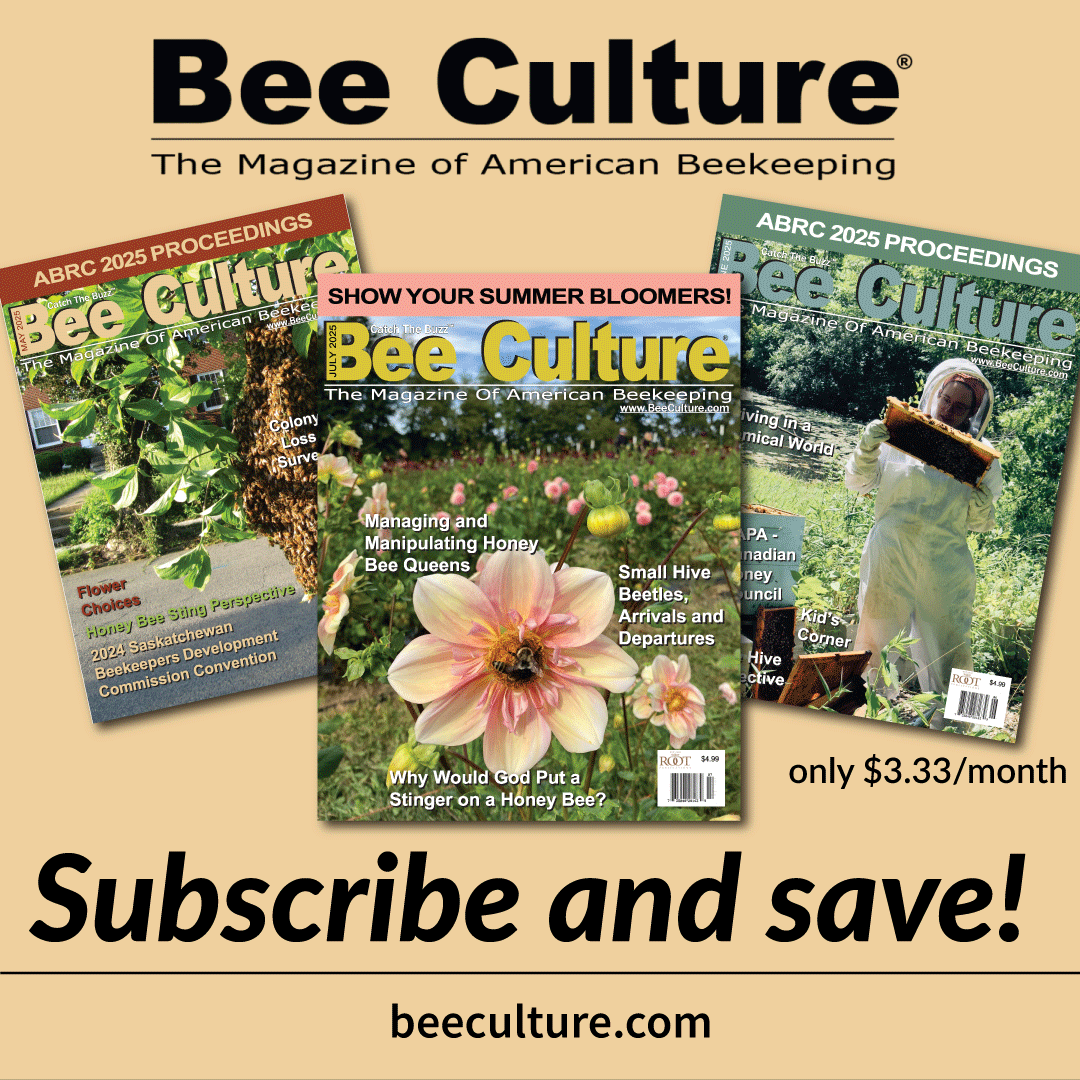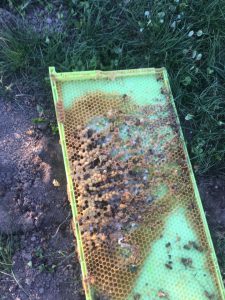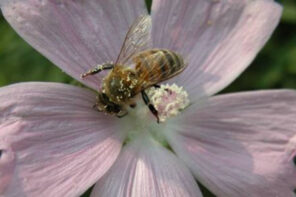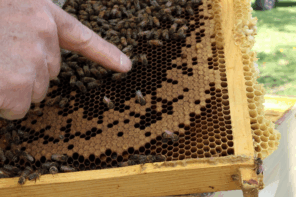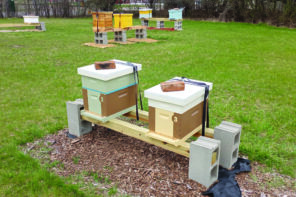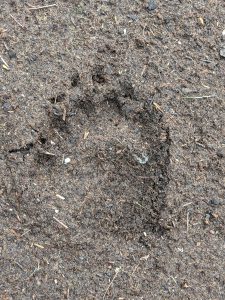
A photograph of a rear foot of a bear. Photo by Amy Massey, taken at the city hall park in Leavenworth, WA.
Emily Harbury, LVT
What makes a person a beekeeper versus someone who simply has bees, or as I call them, a bee-haver? Both categories share a fascination with the honey bee species, but once you delve into them, the differences become more apparent.
I define a beekeeper as: a person who takes an involved management style to protect the health and well-being of their hives. Their management includes integrated pest management (IPM), active predator prevention, knowledgeable and seasonally appropriate hive handling and continued pursuit of their own education of best practices. A good beekeeper works to educate the general public on the value of backyard beekeeping.
A bee-haver, on the other hand, is a person who keeps bees but does the bare minimum or nothing to promote a healthy hive. Many have been misled by false claims that bees will take care of themselves with little interference. In the past, these hives may have remained healthy and produced a crop of honey despite the haver’s ignorance or neglect. These days, however, diseases, predation and collapse will plague these hives, and new bees will need to be purchased almost every year. Lax bee management allows parasites to grow and spread, causing damage to otherwise healthy hives.
The days of beehives remaining healthy without thoughtful care are gone. Some challenges beekeepers now face include the introduction and proliferation of the varroa mite, the invasion of the giant Asian hornet, the infective longevity of American Foulbrood disease, as well as growing resistance to the drugs we’ve used to combat disease and predators. These challenges combined with fewer people able to keep backyard beehives due to small lot sizes and city ordinance laws, have put beekeeping as a hobby and industry in jeopardy.
I could write a whole paper on each challenge beekeepers face, but I will try to capture the essence of what being a beekeeper entails.
Integrated pest management (IPM) uses a variety of pest management techniques that focus on pest prevention, pest reduction and the elimination of conditions that lead to pest infestations. IPM simply means (1) don’t attract pests, (2) keep them out and (3) get rid of them with the safest, most effective methods. IPM is essential for a healthy hive, or at least one that can survive Winter. Varroa mites are one of the biggest threats to the hive. There are many IPM protocols to choose from depending on your situation. Options include a rotating cycle of oxalic acid, formic pro or thymol products along with implementing drone comb frames in the Summer. Some people have success only using essential oils and drone comb frame protocol. With any of these protocols you’ll have to keep track of the extent of the varroa mite population or the success of your IPM with frequent, thorough inspections.
Mite counts in the Summer/Fall are essential to gauge the overall health of your hive. High mite count is a huge factor contributing to Winter death and catching it early will help you choose what products to treat it with. However, repeated exposure to the same product can lead to the mites developing resistance to certain products.
High mite counts also lead to queen death, deformed wing virus or a weakened hive vulnerable to other infesting pests. A weak hive may fail and collapse or abscond. If the hive collapses, bees from healthy hives will come rob it, unwittingly exposing themselves and their healthy hives to mites still residing in the collapsed hive.
Frequent inspections are imperative for a keeper to monitor the overall health of their hives and evaluating their management strategies. Whether a hive is preparing to swarm and needs to be split or a second brood box added. You cannot know what the hive needs unless you observe and investigate. Asking questions as you learn beekeeping will also help you manage each hive successfully. In the Summer, inspecting your hive every seven to 10 days is ideal.
Predator prevention is another necessary action to protect your beehives and safeguard your neighbors. I live in a suburban setting where bears roam, but I didn’t think they would breech my fence nor saunter past my barking dogs. I was wrong. A bear went right over my fence while my dogs slept soundly knocking my hives over so he could eat delicious brood. This was an expensive lesson against complacency. Not only were my hives damaged, but now the bear knew about hives and could become a threat to the other local beekeepers in my area. I may have created a potential nuisance bear. A fed bear is a dead bear. Learn from my mistake and put up a bear fence before a bear feeds on your hive. Taking a “let’s see what happens” attitude risks your own hives, your neighbor’s hives and the future of that bear. After that incident I quickly erected a highly electrified double bear fence, started playing talk radio in the bee yard at night, and have had no visits from bears since that moment five years ago.
Any person with bees becomes a spokesperson for all beekeepers. Public awareness and outreach should be in the forefront of every keeper’s mind when deciding where to put their hives. Consider your bees’ flight path. Flight path is the entrance of the hive where your bees will be leaving and entering. This path can get very busy during the Summer months as hundreds of bees come and go throughout a nice Summer day. If the hive decides to swarm, thousands of bees will pour out of that opening all at once. Position your hive where the public doesn’t have access to it: out of sight, out of mind. Vandals have been known to tip over beehives just for the reckless thrill of literally stirring the hornets’ nest.
Keeping your hives out of sight and away from pedestrian walkways will also help define a flight path for your bees. Keep in mind if there are negative reports to the city lawmakers, this will lead to tightened city ordinance laws. The benefits of being a spokesperson for beekeepers is that your neighbors will think of you if they come across a swarm and call you. Free bees are always a sweet happenstance.
This article is aimed at the newly christened beekeeper with the goal of informing the new or prospective beekeepers of the tasks and knowledge required to become a responsible beekeeper. Joining my local beekeeping club was one of the most beneficial things I did when I was just starting out. The beekeeping industry is always changing, and this will help you keep on top of things like the ever-shifting management strategies in response to invasive species like the giant Asian hornet and the more resistant varroa mite species. Or feed directives that require veterinary approval to obtain antibiotics or other prescription medications. Keeping your mind open and free of bias and allowing yourself to accept fault will be key to your success when faced with any problem in your hives. YouTube videos and online articles will only get you so far and may steer you in a totally unhelpful direction. By joining a club, you gain access to a hive mind. The majority of members will be helpful and eager to share information, and you will make lifelong friends.



